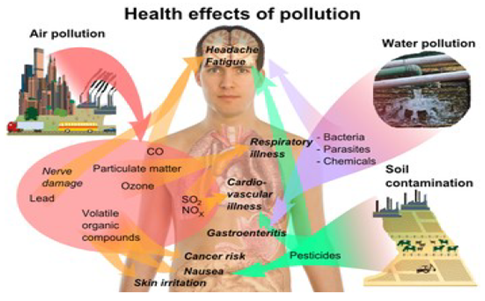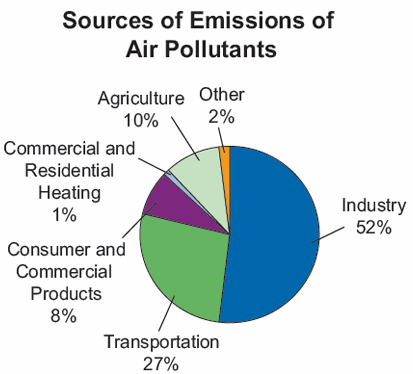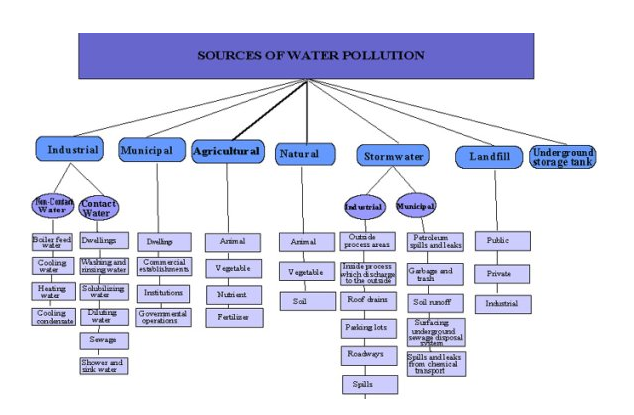Pollution is the introduction of contaminants into the natural environment that cause adverse change. Pollution can take the form of chemical substances or energy, such as noise, heat or light. Pollutants, the components of pollution, can be either foreign substances/energies or naturally occurring contaminants. Pollution is often classed as point source or nonpoint source pollution.
Forms of pollution
The major forms of pollution are listed below along with the particular contaminant relevant to each of them:
- Air pollution: the release of chemicals and particulates into the atmosphere. Common gaseous pollutants include carbon monoxide, sulfur dioxide, chlorofluorocarbons (CFCs) and nitrogen oxides produced by industry and motor vehicles. Photochemical ozone and smog are created as nitrogen oxides and hydrocarbons react to sunlight. Particulate matter, or fine dust is characterized by their micrometre size PM10 to PM2.5.
- Light pollution: includes light trespass, over-illumination and astronomical interference.
- Littering: the criminal throwing of inappropriate man-made objects, unremoved, onto public and private properties.
- Noise pollution: which encompasses roadway noise, aircraft noise, industrial noise as well as high-intensity sonar.
- Soil contamination occurs when chemicals are released by spill or underground leakage. Among the most significant soil contaminants are hydrocarbons, heavy metals, MTBE, herbicides, pesticides and chlorinated hydrocarbons.
- Radioactive contamination, resulting from 20th century activities in atomic physics, such as nuclear power generation and nuclear weapons research, manufacture and deployment.
- Thermal pollution, is a temperature change in natural water bodies caused by human influence, such as use of water as coolant in a power plant.
- Visual pollution, which can refer to the presence of overhead power lines, motorway billboards, scarred landforms (as from strip mining), open storage of trash, municipal solid waste or space debris.
- Water pollution, by the discharge of wastewater from commercial and industrial waste (intentionally or through spills) into surface waters; discharges of untreated domestic sewage, and chemical contaminants, such as chlorine, from treated sewage; release of waste and contaminants into surface runoff flowing to surface waters (including urban runoff and agricultural runoff, which may contain chemical fertilizers and pesticides); waste disposal and leaching into groundwater; eutrophication and littering.
- Plastic pollution: involves the accumulation of plastic products in the environment that adversely affects wildlife, wildlife habitat, or humans.

Air Pollution
Air pollution is the introduction of particulates, biological molecules, or other harmful gases into Earth’s atmosphere, causing disease, death to humans, damage to other living organisms such as food crops, or the natural or built environment. Air pollution may come from anthropogenic or natural sources.
The atmosphere is a complex natural gaseous system that is essential to support life on planet Earth. Stratospheric ozone depletion due to air pollution has been recognized as a threat to human health as well as to the Earth’s ecosystems.
Indoor air pollution and urban air quality are listed as two of the world’s worst toxic pollution problems in the 2008 Blacksmith Institute World’s Worst Polluted Places report. According to the 2014 WHO report, air pollution in 2012 caused the deaths of around 7 million people worldwide.

Sources – There are various locations, activities or factors which are responsible for releasing pollutants into the atmosphere. These sources can be classified into two major categories.
Anthropogenic (man-made) sources: These are mostly related to the burning of multiple types of fuel.
- Stationary sources include smoke stacks of power plants, manufacturing facilities (factories) and waste incinerators, as well as furnaces and other types of fuel-burning heating devices. In developing and poor countries, traditional biomass burning is the major source of air pollutants; traditional biomass includes wood, crop waste and dung.
- Mobile sources include motor vehicles, marine vessels, and aircraft.
- Controlled burn practices in agriculture and forest management. Controlled or prescribed burning is a technique sometimes used in forest management, farming, prairie restoration or greenhouse gas abatement. Fire is a natural part of both forest and grassland ecology and controlled fire can be a tool for foresters. Controlled burning stimulates the germination of some desirable forest trees, thus renewing the forest.
- Fumes from paint, hair spray, varnish, aerosol sprays and other solvents
- Waste deposition in landfills, which generate methane. Methane is highly flammable and may form explosive mixtures with air. Methane is also an asphyxiant and may displace oxygen in an enclosed space.
- Military resources, such as nuclear weapons, toxic gases, germ warfare and rocketry
Natural sources
- Dust from natural sources, usually large areas of land with few or no vegetation
- Methane, emitted by the digestion of food by animals, for example cattle
- Radon gas from radioactive decay within the Earth’s crust. Radon is a colorless, odorless, naturally occurring, radioactive noble gas that is formed from the decay of radium. It is considered to be a health hazard. Radon gas from natural sources can accumulate in buildings, especially in confined areas such as the basement and it is the second most frequent cause of lung cancer, after cigarette smoking.
- Smoke and carbon monoxide from wildfires
- Vegetation, in some regions, emits environmentally significant amounts of VOCs on warmer days. These VOCs react with primary anthropogenic pollutants—specifically, NOx, SO2, and anthropogenic organic carbon compounds — to produce a seasonal haze of secondary pollutants. Black gum, poplar, oak and willow are some examples of vegetation that can produce abundant VOCs.
- Volcanic activity, which produces sulfur, chlorine, and ash particulates
Water Pollution
Water pollution is the contamination of water bodies (e.g. lakes, rivers, oceans, aquifers and groundwater). This form of environmental degradation occurs when pollutants are directly or indirectly discharged into water bodies without adequate treatment to remove harmful compounds.
Water pollution affects the entire biosphere – plants and organisms living in these bodies of water. In almost all cases the effect is damaging not only to individual species and population, but also to the natural biological communities.

Causes – The specific contaminants leading to pollution in water include a wide spectrum of chemicals, pathogens, and physical changes such as elevated temperature and discoloration. While many of the chemicals and substances that are regulated may be naturally occurring (calcium, sodium, iron, manganese, etc.) the concentration is often the key in determining what is a natural component of water and what is a contaminant. High concentrations of naturally occurring substances can have negative impacts on aquatic flora and fauna.
Oxygen-depleting substances may be natural materials such as plant matter (e.g. leaves and grass) as well as man-made chemicals. Other natural and anthropogenic substances may cause turbidity (cloudiness) which blocks light and disrupts plant growth, and clogs the gills of some fish species.
Many of the chemical substances are toxic. Pathogens can produce waterborne diseases in either human or animal hosts. Alteration of water’s physical chemistry includes acidity (change in pH), electrical conductivity, temperature, and eutrophication. Eutrophication is an increase in the concentration of chemical nutrients in an ecosystem to an extent that increases in the primary productivity of the ecosystem. Depending on the degree of eutrophication, subsequent negative environmental effects such as anoxia (oxygen depletion) and severe reductions in water quality may occur, affecting fish and other animal populations.
Ground Water Depletion
Groundwater Pollution of groundwater resources has become a major problem today. The pollution of air, water, and land has an affect on the pollution and contamination of groundwater. The solid, liquid, and the gaseous waste that is generated, if not treated properly, results in pollution of the environment; this affects groundwater too due to the hydraulic connectivity in the hydrological cycle. For example, when the air is polluted, rainfall will settle many pollutants on the ground, which can then seep into and contaminate the groundwater resources. Water extraction without proper recharge and leaching of pollutants from pesticides and fertilizers into the aquifers has polluted groundwater supplies. In addition, leachates from agriculture, industrial waste, and the municipal solid waste have also polluted surface- and ground-water. Some 45 million people the world over are affected by water pollution marked by excess fluoride, arsenic, iron, or the ingress of salt water.
An uncontrolled use of the borewell technology has led to the extraction of groundwater at such a high rate that often recharge is not sufficient. The causes of low water availability in many regions are also directly linked to the reducing forest cover and soil degradation
Soil Pollution
Soil contamination or soil pollution is caused by the presence of xenobiotic (human-made) chemicals or other alteration in the natural soil environment. It is typically caused by industrial activity, agricultural chemicals, or improper disposal of waste. The most common chemicals involved are petroleum hydrocarbons, polynuclear aromatic hydrocarbons (such as naphthalene and benzo(a)pyrene), solvents, pesticides, lead, and other heavy metals. Contamination is correlated with the degree of industrialization and intensity of chemical usage.
The concern over soil contamination stems primarily from health risks, from direct contact with the contaminated soil, vapors from the contaminants, and from secondary contamination of water supplies within and underlying the soil. Mapping of contaminated soil sites and the resulting cleanup are time consuming and expensive tasks, requiring extensive amounts of geology, hydrology, chemistry, computer modeling skills, and GIS in Environmental Contamination, as well as an appreciation of the history of industrial chemistry.
Soil pollution can be caused by the following
- Accidental Spills
- Acid rain (Which is caused by air pollution)
- Intensive farming
- Deforestation
- Genetically modified plants
- Nuclear wastes
- Industrial Accidents
- Landfill and illegal dumping
- Land Erosion
- Agricultural practices, such as application of pesticides, herbicides and fertilizers
- Mining and other industries
- Oil and fuel dumping
- Buried wastes
- Disposal of coal ash
- Disposal of ammunitions and agents of war.
- Drainage of contaminated surface water into the soil
- Electronic waste
The most common chemicals involved are petroleum hydrocarbons, solvents, pesticides, lead, and other heavy metals.

